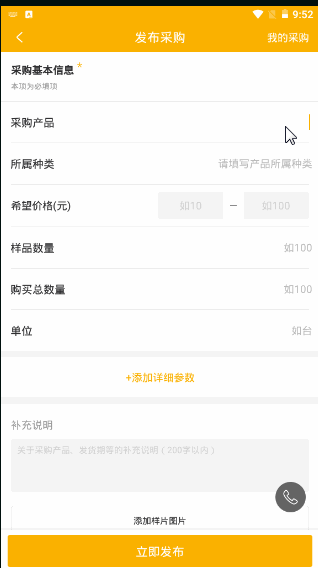解決EditText的gravity設定為right時,在android 7.0之上游標變細
阿新 • • 發佈:2019-02-04
問題闡述:
根據需求,需要設定EditText從後往前輸入,游標預設在輸入文字的末尾,如圖所示:
暴力思路:
這種經常的做法是使用一個TextView覆蓋在EditText來偽裝EditText的提示文字。實際操作時卻發現在android6.0及以下沒有問題,在更高版本中,卻出現游標定位在末尾的時候特別細的情況,顯然是不合格的。網上搜索解決辦法不多,沒辦法,只有自己來了。由於專案中這種輸入形式較多,索性做成自定義組合控制元件統一處理,解決思路:游標顯示異常只出現在高版本,並且是游標在末尾的時候才出現,由於是顯示問題,大可使用障眼法解決,何不讓EditText末尾追加一個空格,另外讓使用者使用時游標定位不到末尾。
解決之道:
佈局很簡單,裡面使用了專案中的樣式,見諒,如下:
<LinearLayout xmlns:android="http://schemas.android.com/apk/res/android" android:id="@+id/ll" style="@style/LLWithPaddingStyle"> <TextView android:id="@+id/tv_title" style="@style/TvLeftWapStyle" /> <FrameLayout android:layout_width="match_parent" android:layout_height="wrap_content"> <com.hc360.koiambuyer.widget.SelectionEditText android:id="@+id/et_input" style="@style/TvRightStyle" android:layout_width="match_parent" android:layout_height="wrap_content" android:layout_marginRight="0dp" android:background="@null" android:maxLines="4" android:textCursorDrawable="@drawable/shape_et_cursor" android:gravity="right|center_vertical" android:textColor="@color/tvNormalColor" /> <TextView android:id="@+id/tv_et_hint" android:layout_width="match_parent" android:layout_height="wrap_content" android:layout_marginRight="9dp" android:gravity="right|center_vertical" android:text="@string/personal_data_name_hint" android:textColor="@color/HintColor" /> </FrameLayout> </LinearLayout>
定義一些距離自定義屬性
<declare-styleable name="EditInput"> <attr name="ei_paddingBottom" format="dimension"/> <attr name="ei_paddingTop" format="dimension"/> <attr name="ei_paddingLeft" format="dimension"/> <attr name="ei_paddingRight" format="dimension"/> </declare-styleable>
自定義組合控制元件,註釋已經很明白了,也很簡單,就不多說了
public class EditInput extends LinearLayout {
private static final float PADDING_DEFAULT = 20;
private static final float PADDING_DEFAULT_LEFT = 15;
private static final float ANDROID_SDK_NUM= 24;
@BindView(R.id.tv_title)
TextView mTvTitle;
@BindView(R.id.et_input)
SelectionEditText mEtInput;
@BindView(R.id.tv_et_hint)
TextView mTvEtHint;
@BindView(R.id.ll)
LinearLayout mLl;
public EditInput(Context context) {
this(context, null);
}
public EditInput(Context context, AttributeSet attrs) {
this(context, attrs, 0);
}
public EditInput(Context context, AttributeSet attrs, int defStyle) {
super(context, attrs, defStyle);
View.inflate(context, R.layout.layout_et, this);
ButterKnife.bind(this);
try {
//獲取自定義屬性
TypedArray a = context.obtainStyledAttributes(attrs, R.styleable.CircleImageView);
int paddingBottom = a.getDimensionPixelSize(R.styleable.EditInput_ei_paddingBottom,
(int) TypedValue.applyDimension(TypedValue.COMPLEX_UNIT_DIP, PADDING_DEFAULT,
getResources().getDisplayMetrics()));
int paddingLeft = a.getDimensionPixelSize(R.styleable.EditInput_ei_paddingLeft,
(int) TypedValue.applyDimension(TypedValue.COMPLEX_UNIT_DIP, PADDING_DEFAULT_LEFT,
getResources().getDisplayMetrics()));
int paddingRight = a.getDimensionPixelSize(R.styleable.EditInput_ei_paddingRight,
(int) TypedValue.applyDimension(TypedValue.COMPLEX_UNIT_DIP, PADDING_DEFAULT_LEFT,
getResources().getDisplayMetrics()));
int paddingTop = a.getDimensionPixelSize(R.styleable.EditInput_ei_paddingTop,
(int) TypedValue.applyDimension(TypedValue.COMPLEX_UNIT_DIP, PADDING_DEFAULT,
getResources().getDisplayMetrics()));
mLl.setPadding(paddingLeft,0,0,0);
mEtInput.setPadding(0,paddingTop,paddingRight,paddingBottom);
mTvEtHint.setPadding(0,paddingTop,10,paddingBottom);
}catch (Exception e){}
//當EditText獲取焦點的時候,覆蓋的TextView就消失
mEtInput.setOnFocusChangeListener(new OnFocusChangeListener() {
@Override
public void onFocusChange(View v, boolean hasFocus) {
if (hasFocus){
mTvEtHint.setVisibility(GONE);
}else {
if (!TextUtils.isEmpty(mEtInput.getText().toString().trim())){
mTvEtHint.setVisibility(GONE);
}else {
mTvEtHint.setVisibility(VISIBLE);
}
}
}
});
//android7.0之上執行這段程式碼
if (Build.VERSION.SDK_INT >= ANDROID_SDK_NUM) {
//初始是EditText追加空格,游標定位到空格的前面
mEtInput.setText(" ");
mEtInput.setSelection(0);
//EditText的游標變化監聽,當游標位置到末尾時,強制將游標改為空格的前面
mEtInput.setOnSelectionChange(new SelectionEditText.OnSelectionChange() {
@Override
public void onSelectionChange(int selStart, int selEnd) {
String etText = mEtInput.getText().toString();
if (etText.endsWith(" ")){
if (selStart == mEtInput.getText().toString().length()){
mEtInput.setSelection(mEtInput.getText().toString().length()-1);
}
}
}
});
//確保EditText輸入文字在空格的前面,游標在空格的前面
mEtInput.addTextChangedListener(new CustomTextWatcher() {
@Override
public void afterTextChanged(Editable s) {
if (!mEtInput.getText().toString().endsWith(" ")){
mEtInput.setText(s+" ");
}
if (mEtInput.getSelectionStart() == s.length()){
mEtInput.setSelection(s.length()-1);
}
}
});
}
}
/**
* 初始化標題跟EditText的提示文字
* @param title
* @param contentHint
*/
public void initText(String title,String contentHint){
mTvTitle.setText(title);
mTvEtHint.setText(contentHint);
}
/**
* 設定EditText的輸入內容
* @param text
*/
public void setEtText(String text){
//高版本末尾追加空格,設定游標在空格前
if (!TextUtils.isEmpty(text)){
if (Build.VERSION.SDK_INT >= ANDROID_SDK_NUM) {
text = text+" ";
mEtInput.setText(text);
mEtInput.setSelection(text.length()-1);
}else {
mEtInput.setText(text);
mEtInput.setSelection(text.length());
}
mTvEtHint.setVisibility(GONE);
}else {
if (Build.VERSION.SDK_INT >= ANDROID_SDK_NUM) {
mEtInput.setText(" ");
mEtInput.setSelection(0);
}
}
}
/**
* 獲取輸入的文字,記得要trim一下,因為EditText可能設定只能輸入數字型別等等
* @return
*/
public String getEtText(){
return mEtInput.getText().toString().trim();
}
/**
* 設定最大輸入文字數
* @param max
*/
public void setEtMaxNum(int max){
mEtInput.addTextChangedListener(new MaxNumTextWatcher(max, mEtInput));
}
/**
* 設定輸入格式
* @param type
*/
public void setEtInputType(int type){
mEtInput.setInputType(type);
}
}裡面使用的SelectionEditText其實就是一個EditText,只不過是暴漏了游標變化的監聽
public class SelectionEditText extends EditText {
OnSelectionChange mOnSelectionChange;
public SelectionEditText(Context context, AttributeSet attrs) {
super(context, attrs);
// TODO Auto-generated constructor stub
}
@Override
public void onDraw(Canvas canvas) {
super.onDraw(canvas);
}
@Override
protected void onSelectionChanged(int selStart, int selEnd) {
// TODO Auto-generated method stub
super.onSelectionChanged(selStart, selEnd);
if (mOnSelectionChange !=null){
mOnSelectionChange.onSelectionChange(selStart,selEnd);
}
}
public void setOnSelectionChange(OnSelectionChange onSelectionChange){
mOnSelectionChange = onSelectionChange;
}
public interface OnSelectionChange{
void onSelectionChange(int selStart, int selEnd);
}
}
